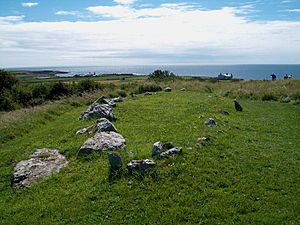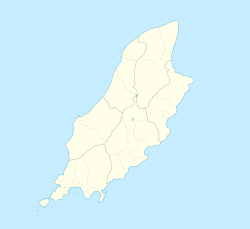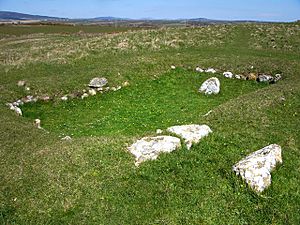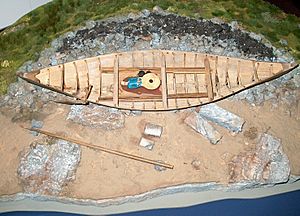Balladoole facts for kids

The stone outline of the Viking boat burial
|
|
| Location | Chapel Hill, Balladoole, Arbory |
|---|---|
| Region | Isle of Man |
| Coordinates | 54°04′47″N 4°40′55″W / 54.07964°N 4.68203°W |
| History | |
| Periods | Mesolithic, Bronze Age, Iron Age, Medieval, Viking |
| Site notes | |
| Archaeologists | Gerhard Bersu, Basil Megaw, J.R. Bruce |
| Ownership | Manx National Heritage |
| Public access | Yes |
Chapel Hill, Balladoole is a really old and important historical place on the Isle of Man, in a town called Arbory. It's near Castletown in the south of the island, sitting on a small hill that looks out over the sea. People have dug up and studied this site a lot, especially in the 1900s. A German archaeologist named Gerhard Bersu did some important digs here in 1944-1945. He was actually staying on the Isle of Man during World War II.
This hilltop has been used for special purposes for thousands of years. Digs have found signs of early human life from the Mesolithic period (Stone Age). There's also a Bronze Age burial spot, an Iron Age hill fort, a small Christian chapel called a keeill, a Christian burial ground, and even a Viking boat burial!
Contents
Discovering Balladoole's Past
The first big dig at Balladoole happened near the end of World War II. Gerhard Bersu, a German archaeologist, and his wife were living on the Isle of Man. They were considered "enemy aliens" at the time. But Bersu was allowed to lead a team of other people staying there to dig up important historical sites on the island.
Because they were not regular workers, they couldn't use big tools like pickaxes. Instead, they had to dig very carefully with small hand tools called trowels. The amazing discovery of the Viking boat burial was actually a surprise! Bersu and his team were originally looking for an Iron Age hill fort.
Other archaeologists also explored the site later. Basil Megaw, who was in charge of the Manx Museum, dug here in 1951. J.R. Bruce also did more work in 1974.
What Was Found at Balladoole?
Archaeologists have found many different things at Balladoole, showing how people used this spot over thousands of years.
Stone Age Camps
They found remains of ancient rubbish piles, called middens, left by early hunter-gatherer groups. These finds show that people were active at Balladoole way back in the Mesolithic period, which was a very early part of the Stone Age.
Bronze Age Burial
On the north side of the hill, there are traces of a small Bronze Age burial cist. A cist is a stone-lined box used for burials. This one dates back to about 1000 BC. It's missing its top stone, and no treasures were found inside it. However, tiny pieces of a Bronze Age cremation pot were found under the floor of the later Christian chapel. This suggests that Christians might have built their chapel on top of a much older burial site.
Iron Age Hill Fort
The site is surrounded by an earthwork promontory hill fort. This means it was a defensive wall made of earth and stone. Not much of the original stone wall is left, but the amount of fallen stone found suggests it might have been as tall as 3 meters in some places!
They also found holes where very large wooden gates might have stood. These holes helped scientists figure out how old the hill fort is. While it might have been used for defense, some large gaps in the earthwork make experts wonder how strong its defenses really were.
The Ancient Chapel: Keeill Vael
The remains of an old chapel, called a keeill, were found here. It dates back to between 900 AD and 1000 AD. A keeill is a small, simple chapel built on the Isle of Man between the 6th and 12th centuries. This keeill is why the place is now called Chapel Hill!
Not much of the original keeill is left. In the 1800s, many of its stones were taken to build other things nearby. The only part that really remains is the doorway on the south wall. The keeill was built on top of an older, flat stone platform. As mentioned, tiny pieces of a Bronze Age pot found underneath suggest that Christians built their chapel on a spot that was already special to people from long ago. Because the keeill was so small, it wasn't used for large church services. It was likely used for private prayers or special religious ceremonies.
Christian Burial Ground
Balladoole is also home to an ancient Christian burial ground. In the 1940s, Bersu dug up seventeen early Medieval graves. These graves were lined with stones. Some of these Christian graves were disturbed by the later Viking burial.
The Viking Boat Burial
In 1945, Gerhard Bersu uncovered the remains of an 11-meter-long Viking boat. This boat dates back to between 850 AD and 950 AD. It was a clinker-built oak vessel, which means its wooden planks overlapped like roof tiles. This type of boat was common for trading in the Irish Sea during the Viking Age.
Even though the boat's wood has long rotted away, the iron nails that held it together show its exact shape. A stone mound, called a cairn, still outlines the boat today. A large mound of earth would have covered the burial site. However, much of this earth was removed during Bersu's digs because they thought it was part of the older Iron Age fort.
The burial site is about 350 meters uphill from the coast and is at the highest point of the hill. This means it would have taken a lot of people and effort to drag the boat up there! This suggests that the person buried in the boat was very important in their community. They might have been a powerful landowner, a chieftain, or a wealthy merchant.
The burial mound was covered with the burnt remains of animals. The presence of at least one other body suggests a special kind of burial, perhaps to honor the main person. Many important items, known as grave goods, were found in the Viking boat burial at Balladoole. Many of these are now on display at the Manx Museum in Douglas. These items included:
- A bronze ring-headed pin
- A fancy gilded belt buckle
- Iron knives
- A flint strike-a-light (used to start fires)
- An iron cauldron
- The most exciting finds were riding gear: a bridle, stirrups, and spurs with decorative buckles.
- There was also a shield, but no sword.
The Viking boat was buried directly on top of and into older Christian graves. This might have been a deliberate act to show the power of the pagan Norse people over the local Christians.




